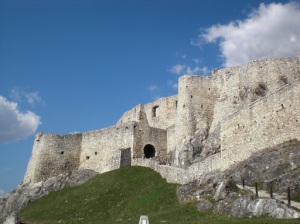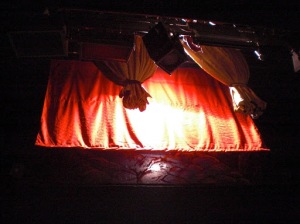When I came to Gdańsk in February, my friend Karol suggested that one of these days he’d show me his home town Grudziądz, some 120 kilometers south of Trójmiasto (Tricity, the city complex Gdańsk is part of). Grudziądz is one of the countless middle sized towns in Western Poland with a long and difficult Polish-German history – and in that sense it might not be immensely unique. However, I have come to find out that each and every one of these places has their own charms and their own stories to tell; and all the more so when you get to discover them with a local. I never had to think twice. So on this beautiful day in May, Karol and our mutual friend Aga pick me up at the hostel. We pack up our umbrellas – it is supposed to be a warm but rainy day – and board Karol’s little old Opel to leave Gdańsk in bright sunshine.
I have already described my very first impression of the town in this post. We approach the city via Malinowski bridge and the cityscape touches upon those places in my heart reserved for a feeling of home. I love it instantaneously. As we pull into town, we park the car in the parking lot of Karol’s old school.
 Beautiful red brick stone buildings abound, and students dressed up in suits and fancy dresses – Aga walks up to them and asks them how their matura went, the final exams in Polish high school. They smile shyly and say it went okay, and that the subject was English. I’m reminded of my own high school days. None of us really dressed smugly for the finals. I like it, it adds meaning to the occasion.
Beautiful red brick stone buildings abound, and students dressed up in suits and fancy dresses – Aga walks up to them and asks them how their matura went, the final exams in Polish high school. They smile shyly and say it went okay, and that the subject was English. I’m reminded of my own high school days. None of us really dressed smugly for the finals. I like it, it adds meaning to the occasion.
We walk back to the main street and buy tram tickets at the machine to take a little round trip of the city. The tram is old fashioned and cute.
 It goes right through the narrow and tiny cobble stone streets in the old town. As Aga points out, in Gdańsk it only goes along the large alleys in specific tram trails. Here, cars drive over the tram tracks as well, the ride is thus very lively and gives you a good idea of city life in Grudziądz. We pass by beautiful old houses, in Polish they are called Kamienice which derives from the word kamień, meaning stone.
It goes right through the narrow and tiny cobble stone streets in the old town. As Aga points out, in Gdańsk it only goes along the large alleys in specific tram trails. Here, cars drive over the tram tracks as well, the ride is thus very lively and gives you a good idea of city life in Grudziądz. We pass by beautiful old houses, in Polish they are called Kamienice which derives from the word kamień, meaning stone.
 There are so many of them, the historic structure of the town is amazing – unfortunately they are not too well kept. I personally love the morbid charme that this entails, but Karol rightfully points out that the city deserves to be beautiful to its full potential, and that is not nearly reached. Many buildings are empty on their ground floors where there should be little shops and buzzing life. But I only notice that because Karol and Agnieszka point it out much to me. I revel in the towns gorgeous scenery and in its liveliness as people are walking down the streets in bright early summer sunshine.
There are so many of them, the historic structure of the town is amazing – unfortunately they are not too well kept. I personally love the morbid charme that this entails, but Karol rightfully points out that the city deserves to be beautiful to its full potential, and that is not nearly reached. Many buildings are empty on their ground floors where there should be little shops and buzzing life. But I only notice that because Karol and Agnieszka point it out much to me. I revel in the towns gorgeous scenery and in its liveliness as people are walking down the streets in bright early summer sunshine.

After the tram ride, we walk through the narrow streets lined with Kamienice towards the Rynek, the market square.
 It is your typical Polish market square with pretty old town houses and a monument in the middle. I love these wide open spaces in the middle of an urban area. They give me breathing space and let me see the sky, the add light and freshness to the comfort of narrow streets and tiny alleyways.
It is your typical Polish market square with pretty old town houses and a monument in the middle. I love these wide open spaces in the middle of an urban area. They give me breathing space and let me see the sky, the add light and freshness to the comfort of narrow streets and tiny alleyways.
Karol then takes us up the castle hill and shows us beautiful views of the Vistula river to one side and over the town to the other. It smells like spring, and everything’s in blossom. The leaves on the trees haven’t sprung to their full-fledged green splendour yet – they are still young and light and careful, like symbols of hope.
 After a walk through the botanical garden and a delicious lunch at a Chinese restaurant, we come back to the water front. It may well be my favorite place in Grudziądz. The granaries and the city gate Brama Wodna, Water Gate, sit proudly and eternally next to the glistening river that flows on ever so steadily, ever so calmly, with a certainty I wish I had when it comes to planning my own life.
After a walk through the botanical garden and a delicious lunch at a Chinese restaurant, we come back to the water front. It may well be my favorite place in Grudziądz. The granaries and the city gate Brama Wodna, Water Gate, sit proudly and eternally next to the glistening river that flows on ever so steadily, ever so calmly, with a certainty I wish I had when it comes to planning my own life.
 Next to the raftman’s monument, there is a collection of street signs nailed onto wooden posts of streets all around Europe named after Grudziądz. There is one in Gdańsk, one in Hamburg, and one in Berlin:
Next to the raftman’s monument, there is a collection of street signs nailed onto wooden posts of streets all around Europe named after Grudziądz. There is one in Gdańsk, one in Hamburg, and one in Berlin:
 I find it once more ever so meaningful how in German towns, the streets will be named after Graudenz, which is the German name of Grudziądz, when in Poland they will obviously use the city’s contemporary name. Of course there is German heritage in the city – many of the mentioned Kamienice were surely built when the place was German, and the granaries and the castle area remind of the Teutonic Knights who reigned here in the middle ages. Still, Grudziądz is nothing but Polish to me. I had a short conversation about this with a German guy in the hostel in Gdańsk who said he felt a certain melancholy in the presence of the German heritage of this area, and a sense of loss. I have no idea what that must feel like. This is not lost to me! This is more than accessible, and it is part of me in a new, great way, it is home away from home, it is Polish, but it is not strange or foreign.
I find it once more ever so meaningful how in German towns, the streets will be named after Graudenz, which is the German name of Grudziądz, when in Poland they will obviously use the city’s contemporary name. Of course there is German heritage in the city – many of the mentioned Kamienice were surely built when the place was German, and the granaries and the castle area remind of the Teutonic Knights who reigned here in the middle ages. Still, Grudziądz is nothing but Polish to me. I had a short conversation about this with a German guy in the hostel in Gdańsk who said he felt a certain melancholy in the presence of the German heritage of this area, and a sense of loss. I have no idea what that must feel like. This is not lost to me! This is more than accessible, and it is part of me in a new, great way, it is home away from home, it is Polish, but it is not strange or foreign.
To finish off the day, as we drive out of town, Karol turns soon enough after the other side of Malinowski bridge and takes us to the other shore of the Vistula river to show us this stunning view of his home town:
 The sun has gone down a little, clouds are collecting. The Polish obłoki, tiny cute white fluffy clouds, have turned into chmury, big grey rain clouds, so the promised windstorm may come upon us after all – but for now the sky is still blue, and the summer’s day’s light is still bouncing off the glistening surface of the river. What a blessing to have friends to live through days like these with, and what a gift to be able to visit places like this one in this world.
The sun has gone down a little, clouds are collecting. The Polish obłoki, tiny cute white fluffy clouds, have turned into chmury, big grey rain clouds, so the promised windstorm may come upon us after all – but for now the sky is still blue, and the summer’s day’s light is still bouncing off the glistening surface of the river. What a blessing to have friends to live through days like these with, and what a gift to be able to visit places like this one in this world.
 This is me in May 2010 on the grounds of Travnik Castle in the heart of Bosnia & Hercegovina. Behind me is the bridge crossing the moat – white, eternal, covered in moss and weeds, delightfully morbid and beautiful. This was about 6 weeks into my trip and I had finally truly come to and found my place in this lifestyle that I was so incredibly lucky to live for another 3 1/2 months to come. I was utterly happy, and I think it shows in my face.
This is me in May 2010 on the grounds of Travnik Castle in the heart of Bosnia & Hercegovina. Behind me is the bridge crossing the moat – white, eternal, covered in moss and weeds, delightfully morbid and beautiful. This was about 6 weeks into my trip and I had finally truly come to and found my place in this lifestyle that I was so incredibly lucky to live for another 3 1/2 months to come. I was utterly happy, and I think it shows in my face.



























































